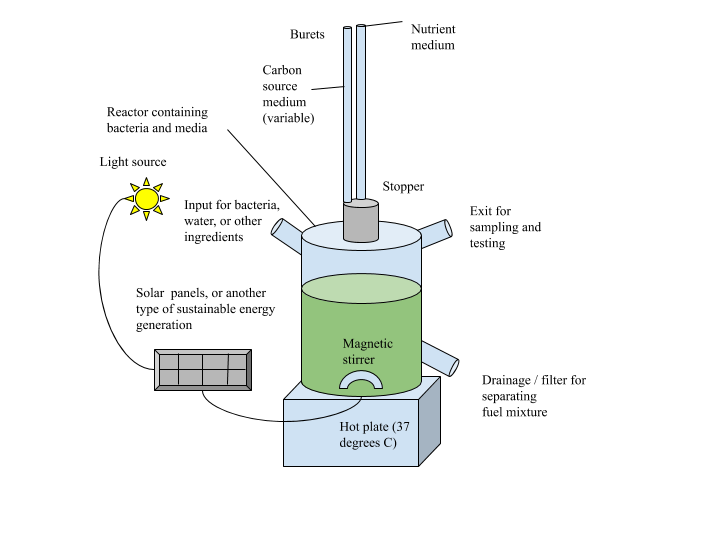About This Project
I will study the effects of three types of sustainable carbon-based media on the biobutanol yield of two types of bacteria in a small bioreactor. Butanol has much potential, as it can be used in combustion engines designed for gasoline and has beneficial fuel properties compared to ethanol. The Clostridium genus has two species (C. acetobutylicum and C. beijerinckii) that can ferment butanol. Glucose is easily digested in respiration, so I predict it will be the most efficient in my reactor.
Ask the Scientists
Join The DiscussionWhat is the context of this research?
Currently, biofuels are an increasingly researched alternative energy because they can be sustainably produced by microorganisms. Biobutanol is a particularly promising compound because it can be used in gasoline engines and has higher energy density and better fuel properties than ethanol. Because of this, much research has been conducted on various metabolic pathways and genetic engineering has been used to efficiently produce high yields of butanol. However, biofuels in general are costly to produce, and do not yet provide high enough benefits to be put into widespread use, although they have much potential. My project aims to fill a hole in current research by directly comparing the yield of butanol from different types of sustainable carbon-based media.
What is the significance of this project?
The unsustainable consumption of fossil fuels is a pressing issue in modern society, because of their capacity to change global climate and because they will soon run out. Biofuels are a possible solution to this problem, but major roadblocks to the use of them are their high cost and low yield of production. It is therefore necessary to find an efficient method to produce biofuels in a low-cost and sustainable manner. This can be done by testing specific types of media to find out which is most efficiently used by a metabolic pathway. My project specifically tests biobutanol, as it has a high energy density and can be widely used. I will test two bacteria species that produce butanol using ABE fermentation with three media types to find which is most efficient.
What are the goals of the project?
The aim of the project is to determine which medium works most efficiently with the ABE fermentation pathway, so my goal is to measure and compare the amounts of butanol produced by the bacteria growing in each medium (corn starch, cellulose, and glucose). To do this, I will need to build a small-scale bioreactor to grow my bacteria, and use a spectrophotometer to measure the concentration of butanol in my product. After this, I will simply compare the values using a Chi-squared or other test, and determine with which medium the most fuel can be produced. I will be able to start in September or October of this upcoming school year, and one trial of my bioreactor will take one school week. If everything goes smoothly, I can finish collecting data in 3-4 months.
Budget
The main need for money is for equipment, media, and bacteria in order to build a small-scale bioreactor. Using the bioreactor and other equipment, I will be able to culture bacteria and measure the amount of butanol produced by them. Much of the materials are available at school, but the items in my budget are specific products that must be purchased online.
The two bacteria species will each be tested three times, with one extra culture of C. acetobutylicum available for testing.
The ethanol assay kit will be used with the spectrophotometer for determining how much ethanol was produced, and then I will use stoichiometry to calculate how much butanol was also produced by the fermentation process.
The glucose solution, cellulose, and corn starch are all media that I will test both species of bacteria with.
Endorsed by
 Project Timeline
Project Timeline
Beginning in September or October, I will build my bioreactor. This should take less than a month, because all materials should be available at school. I will conduct a test with a culture of C. acetobutylicum to ensure my reactor runs smoothly, and begin data collection around November. Data collection will take 1-2 months, because there will be six trials, all one week long. Three trials will use C. acetobutylicum, and three will use C. butyricum.
Oct 15, 2019
Project Launched
Oct 20, 2019
Build bioreactor
Oct 21, 2019
Notify backers of progress with bioreactor
Oct 25, 2019
"Dry" test for bioreactor (no bacteria or media)
Nov 01, 2019
"Wet" test for bioreactor (with test culture of bacteria and media)
Meet the Team
Benjamin Baumgartner
Ever since I read a Scientific American article about researchers creating an "artificial leaf," I have been interested in biofuels and alternative energy in general. I am part of Princeton High School's research program, a three-year course where I design and conduct my own research project. I am currently a junior, and greatly appreciate any and all funding for my project!
Additional Information
This is a diagram of how my bioreactor setup will look. Most materials needed are available at my school (they are not in the budget), but certain specific materials such as bacteria, media, and measuring equipment are still needed.
Project Backers
- 11Backers
- 105%Funded
- $528Total Donations
- $48.00Average Donation

